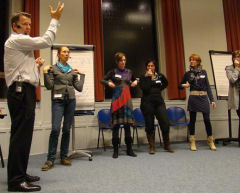
EmotionalBuzz
the resource for meridian energy therapy
What are advanced energy methods?

by Steve Wells
Advanced energy methods (AEM) is a term used to describe a range of techniques and approaches developed by Steve Wells and Dr David Lake which can be used to:
- identify
- attune
- match and
- respond to energy in order to promote positive energetic and emotional shifts.
AEM also includes techniques for:
- reading the other personís energy
- matching other people’s energy style and magnitude
- identifying, and responding to energy blockages in yourself and other people.
There is also advanced skills development such as:
- use of intention with energy work
- methods for working intuitively with others.
Get results with and without tapping
AEM includes techniques for working with tapping as well as some techniques that do not have to involve tapping, although we tend to use tapping in combination with these other techniques at the present time. Some of these techniques owe their origins or their inspiration to other pioneers such as John Mace (Mace Energy Method), Nick Kemp (Tonal Tempo Technique), Willem Lammers (Logosynthesis), Gene Gendlin (Focusing), Frank Farrelly (Provocative Therapy), Milton H Erickson, among others, and some we have created ourselves. We combine all this into an alphabet soup which offers the practitioner a large number of options for working with a range of different clients and presenting issues. For example, there are distinctions for working with those who are very cognitive and not very feeling aware, which are very different from those used with people who are very kinesthetically aware or energy aware.
Creating heart-based connections
One of the most crucial aspects of energy work is the heart connection and AEM includes approaches for connecting with others in ways that create an extraordinary quality of rapport. Key here is having an open heart chakra and accessing an open, loving, accepting state with clients, an optimum state for energy transmission and healing.
Matching energy level and type
Then there is how you match the other person’s level of energy as well as their energy type and their style of communication. There are techniques you can use to work with the various representational components of the energy block, which may also be visually, auditorilly and/or kinesthetically represented. These can be used separately or can be combined with tapping. And these are not just neuro-linguistic programming (NLP) techniques, although there are links and overlaps to some techniques used in NLP and some of the understandings from there can be helpful.
Improving your quality of attention
When you sit down to work with someone on an emotional problem, there are ways of reading what is happening with their energy which can inform your work and help you to help them better. A key part of learning AEM is learning how to pay a higher quality of attention to other people. The practitioner is totally focused in the now, totally awake and aware. This includes paying close attention to what the other person is showing you and telling you, and what they are resonating on an energy level. Noticing what is happening with the other person visually, auditorily, and kinesthetically. can often provide useful information which indicates blockages and shifts in energy and informs how you work with them.
For example, often a client will unconsciously point to where an energy block is in their body when they talk about it, and/or you may notice that their breathing is constricted and/or you can tell that they have an energy block in the upper chest because they only breathe in up to a certain point (because the energy block often manifests seemingly like an actual physical block), and/or you may hear the energy in their voice such as an exhausted sigh or rapid intense speech, and/or you feel it in your own body or sense it in some other way. So AEM also involves a lot of self-awareness, and trusting of your own inner messages. Thus, it also requires much self-work in order to clear your own channels for listening, seeing, and feeling.
Positively using intention
AEM teaches how to use your intention to facilitate healing for the client, and how to form intentions that work to facilitate energy shifts – and there is how you encourage clients to use intention and to access the power of that intention.
Opening to intuition
AEM teaches ways of becoming more intuitive and how you can be more open to and confident in using your own intuition to help others (and generally as you go through life).
There is of course much more than can be conveyed here or contained in one workshop but I believe the participants in our upcoming AEM workshops will be hugely excited by the potential of what they’ll learn.
Steve Wells
For more information on these workshops visit: http://www.eftdownunder.com/london2011.html